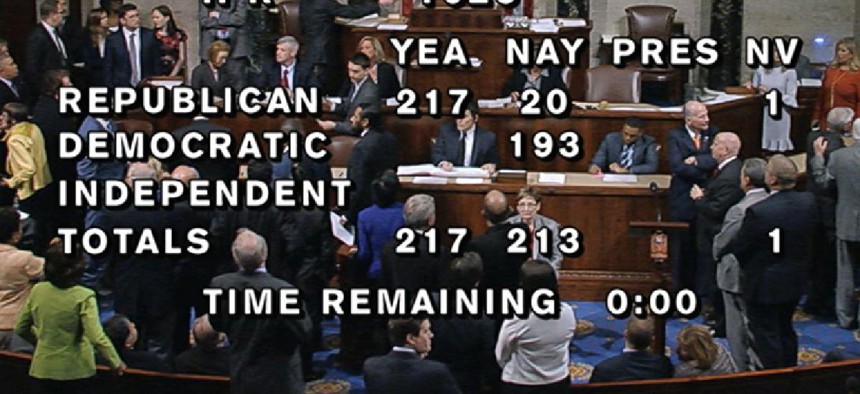Opinion
Obamacare repeal bill could retrigger "death spiral" of New York's health insurance market

What happens when an ill-conceived health care law collides with a mismanaged health care system?
New York could soon find out the hard way – if the House Republicans’ American Health Care Act becomes law.
The House plan, which passed by a whisker Thursday, is heavy on ideological goals – limiting spending, cutting taxes, rolling back regulations – and light on pragmatic steps to make the health care system work.
The charge that 24 million Americans stand to lose their health coverage under the law comes not from U.S. House Minority Leader Nancy Pelosi, but the sober projections of the nonpartisan Congressional Budget Office.
Albany, meanwhile, has for decades gone too far in the other direction. Until a few years ago, it allowed Medicaid to run out of control. It also larded so many taxes and mandates on commercial insurers that it all but destroyed the nongroup market and gave itself the highest premiums in the continental U.S.
The result is that AHCA would hit the state especially hard – including several negative consequences that are unique or nearly unique to New York.
The big picture is that the plan would jeopardize coverage for hundreds of thousands of state residents, cost the state more than $7 billion in federal aid and throw the nongroup insurance market into disarray – possibly retriggering the so-called “death spiral” of soaring premiums and plunging enrollment that it was caught in before Obamacare.
RELATED: New York lawmakers react to House health care vote
Here are some of the details:
Medicaid: AHCA partially rolls back the expansion of Medicaid by leaving eligibility rules in place but phasing out the extra funding. Despite some management improvements by Gov. Andrew Cuomo’s administration, New York still operates one of the richest Medicaid programs in the country and therefore has a lot to lose: more than $2 billion a year in federal aid. The state would face the choice of filling the gap with its own funds, rolling back eligibility or cutting payments to providers
The Collins-Faso amendment: New York shifts $7.6 billion of its Medicaid costs onto local government, by far the most of any state. An amendment sponsored by two of New York’s own representatives, Chris Collins and John Faso, would require Albany to take over this cost for all counties except in New York City. This opens a further $2.3 billion hole in the Medicaid budget and sets up a complicated regional fight in the state Legislature.
The Essential Plan: New York and Minnesota were the only two states to exercise this optional benefit under Obamacare. New York’s version offers Medicaid-like coverage up to 200 percent of the federal poverty level (or an annual income up to $24,120 for an individual) at a cost of no more than $20 a month, with federal aid covering 80 percent of the cost. AHCA would eliminate the program, ending coverage for 635,000 enrollees and costing the state $3 billion. Some enrollees would be eligible for Medicaid; most would be left to buy coverage in the commercial market.
The individual mandate: AHCA would eliminate the requirement for individuals to enroll in health plans, which is one of Obamacare’s least popular provisions. Some younger, healthier New Yorkers would likely drop coverage, increasing the uninsured rate and driving up costs for those who stay in the market.
Abortion: AHCA prohibits the use of federal tax credits to buy plans that cover abortion. However, New York is one of several states that require health plans to cover abortion. Unless the state changes its regulations, New Yorkers using the tax credits would have only one choice: Fidelis Care, a Catholic-affiliated health care plan that does not directly cover abortion or birth control.
RELATED: From Biden to Lentol: Politicians who plagiarize
Age rating: While Obamacare subsidizes the cost of insurance with tax credits based on income, AHCA would replace them with tax credits based on age. They would range from $2,000 annually for those under 30, to $4,000 for those over 60, and would be fully available to everyone up to $75,000 in income. This reflects the fact that health plans in most states charge more to older customers than younger ones. But New York is one of two states (with Vermont) that bans insurance companies from charging different rates based on age. Unless that law changes, younger New Yorkers would face much higher out-of-pocket costs for coverage than older New Yorkers.
The death spiral: The requirement that health plans cover pre-existing conditions without a premium penalty is one of Obamacare’s most popular provisions. But it’s also dangerous unless balanced by the highly unpopular requirement that everyone buy insurance. This is because coverage for pre-existing conditions causes premiums to go up for the young and healthy, who respond by dropping coverage, leaving plans with an older, sicker risk pool, driving premiums even higher, pushing more people to unenroll, and so on. This death spiral all but destroyed New York’s nongroup market from 1992, when the state passed its own protections for pre-existing conditions, until 2014, when Obamacare took full effect. By repealing the individual mandate and scaling back premium support, AHCA would risk pushing New York back into the abyss.
In effect, President Barack Obama’s health reforms helped rescue New York from its own worst impulses, with a surge of funding for Medicaid and the legal supports necessary to make its nongroup insurance market functional again.
If and when Obamacare goes away, the bad habits of the state’s past could come back to haunt it – and average New Yorkers would pay the price.
Bill Hammond is the director of health policy at the Empire Center for Public Policy and a former columnist for the Daily News.
